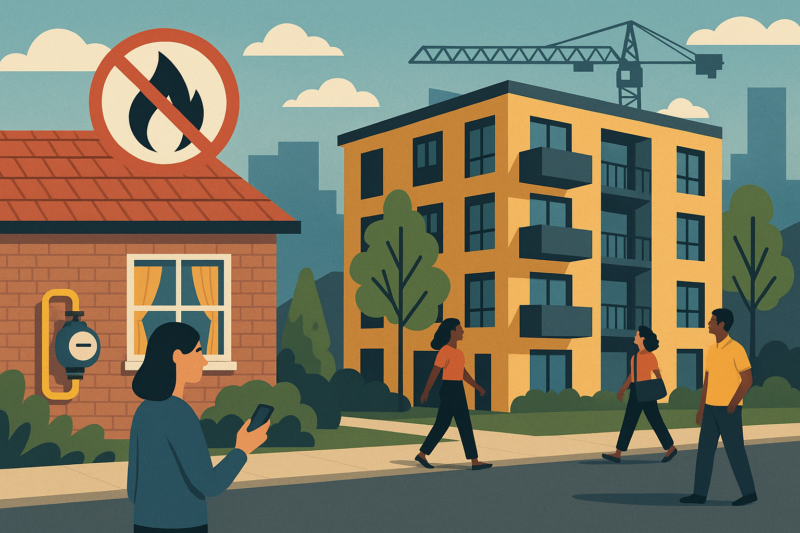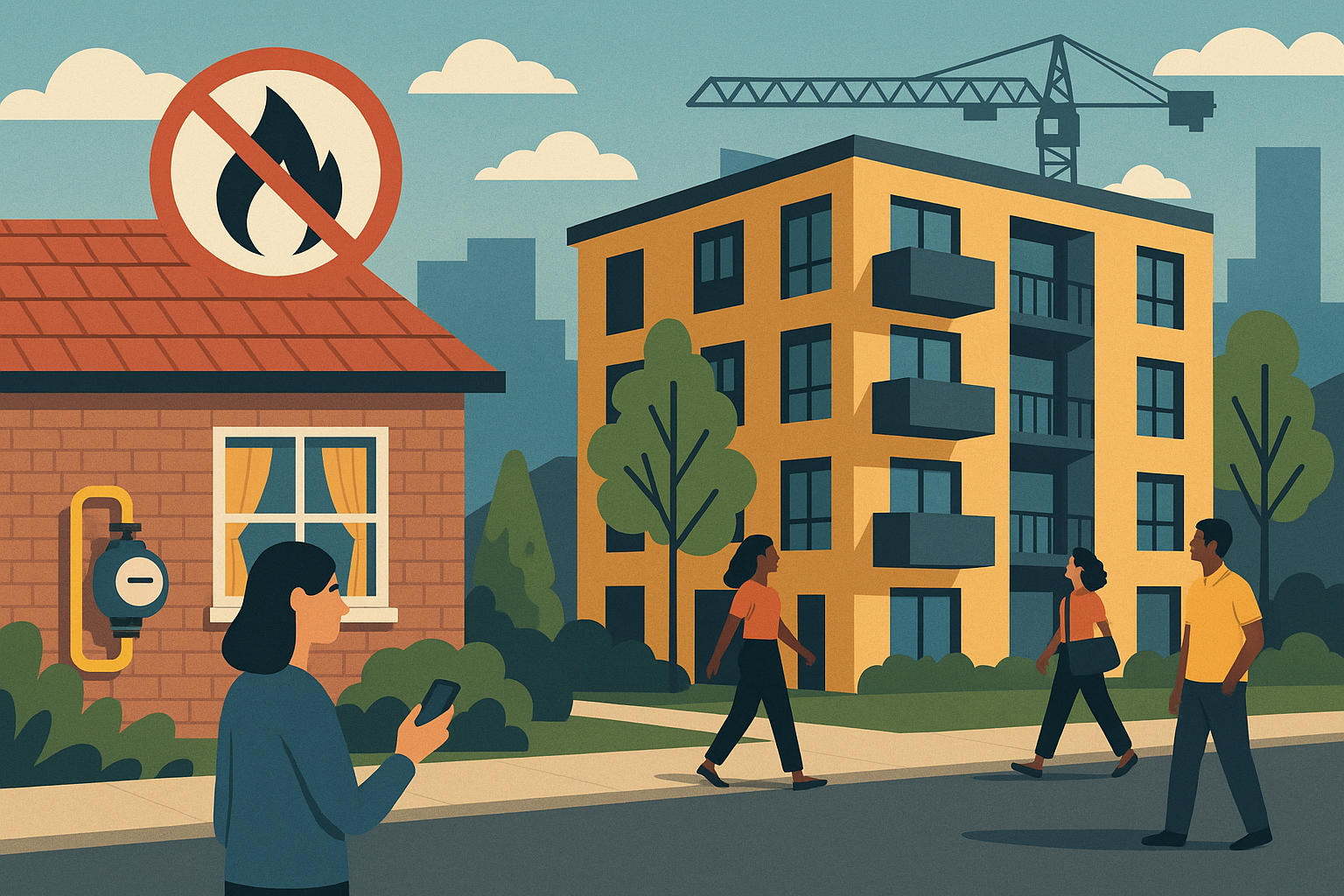
Key takeaways
From Jan 1, 2027: All new homes and most new commercial buildings in Victoria must be built fully electric — no new gas connections for heating, hot water, or cooking.
From Mar 1, 2027: In existing homes, when a gas hot water system fails, it must be replaced with an electric one (e.g., heat pump).
Rentals face tougher rules: Gas hot water and space heating systems must be replaced with electric options at the end of life.
The Victorian government has just turned up the heat, on gas.
In a major shift toward full home electrification, the Allan Labor government has introduced sweeping new regulations that will reshape the way Victorians heat their water, warm their homes, and design their properties.
So what’s actually changing?
And more importantly, what do these reforms mean for homeowners, landlords, and investors like you and me?

The key changes: a shift away from gas
By January 1, 2027, all new homes and most new commercial buildings in Victoria must be built fully electric.
That means no new gas connections for hot water, heating or cooking.
But it doesn’t stop there.
From March 1, 2027, when a gas hot water system in an existing home reaches end-of-life, it must be replaced with an efficient electric alternative, like a heat pump.
Rental homes are being held to an even stricter standard: both gas hot water systems and gas heaters must be replaced with electric alternatives at end of life.
And all new leases will now require a minimum energy efficiency standard, including:
-
Ceiling insulation with a minimum R5.0 rating (if not already installed)
-
Draught sealing around doors, windows and vents
The government claims this could reduce household energy bills by $880 a year, or $1,820 with solar.
Why this matters for property investors
If you're a landlord or developer, these changes aren't just another layer of regulation.
They represent a fundamental shift in how homes will be powered and rated in Victoria and that has both short-term costs and long-term strategic implications:
1. Capital Costs vs Long-Term Gains
Switching from gas to electric hot water and heating does involve upfront costs.
Heat pumps, reverse-cycle air conditioning, insulation, and draught sealing all add up.
But the government is trying to soften the blow with rebates of up to $1,400 from Solar Victoria, plus additional support through the Victorian Energy Upgrades program.
Long-term, however, the payoffs look strong: lower energy bills, better tenant retention, and future-proofing your asset against obsolescence.
If you're a buy-and-hold investor. you already need to be thinking about your property’s compliance and energy efficiency today, not in 2027.
2. Rentals Under the Microscope
One-third of Victorians rent, and under these new rules, rental properties are a clear target.
In fact, the rules are stricter for rental stock than for owner-occupied homes.
For landlords, this means:
-
Compulsory upgrades upon appliance failure
-
Mandatory energy standards at lease commencement
-
Increasing tenant expectations around energy costs and comfort
While that might sound like a regulatory headache, there’s an upside: well-insulated, all-electric homes are in demand.
And they command a premium in the rental market, especially as energy prices rise and renters become savvier about running costs.
Investors who proactively upgrade now may see stronger yields, lower vacancy, and better tenant quality.
Why this isn’t the end for gas just yet
Interestingly, the government backed off from a full ban on replacement gas heaters in owner-occupied homes, for now.
That’s likely due to political pressure from gas lobby groups and opposition parties.
So while gas hot water is being phased out, gas space heating and cooking appliances in owner-occupied homes can still be replaced like-for-like, at least until the next wave of reforms.
This tells me we’re on a transition path, not an instant shift.
But the direction of travel is clear: electrification is inevitable.
Strategic considerations for investors
As always, change creates opportunity, for those who move early and smartly.
Here’s how I’d suggest investors prepare:
1. Audit your portfolio
Take stock of all gas appliances across your rental properties.
Prioritise upgrades for hot water systems nearing end-of-life or properties with new leases coming up.
2. Plan for future expenditure
Budget for heat pump hot water, reverse-cycle heating/cooling, ceiling insulation, and draught sealing.
Costs will rise as demand increases and deadlines approach.
3. Tap into rebates
Make use of the enhanced Victorian Energy Upgrades (VEU) scheme and Solar Victoria rebates while they’re available.
Some rebates are boosted for Australian-made appliances, another incentive.
4. Stay ahead of regulation
Don’t wait until 2027.
Be proactive.
Homes that meet or exceed energy efficiency standards will have a competitive edge in the rental market.
The bigger picture: energy, equity, and market forces
There’s a deeper story here too.
This isn’t just about climate policy, it’s about affordability, equity, and long-term gas supply.
Victoria is facing gas shortfalls as coal plants retire and industrial demand stays strong.
These electrification reforms free up gas for industry, while lowering household bills and emissions.
It’s a rebalancing act.
And renters, often the most energy-insecure, stand to benefit most, finally getting access to better-performing appliances and lower bills.
In this light, the policy is a step toward a fairer, cleaner housing market.
Final thoughts
As always, regulation is neither good nor bad, it’s how you respond that counts.
At Metropole, we see these reforms as an opportunity to improve the quality, appeal, and resilience of your property portfolio.
If you’re investing for the long term, all-electric, energy-efficient homes won’t just be compliance-friendly, they’ll be more profitable too.
The energy landscape is shifting.
Make sure your investment strategy is too.














